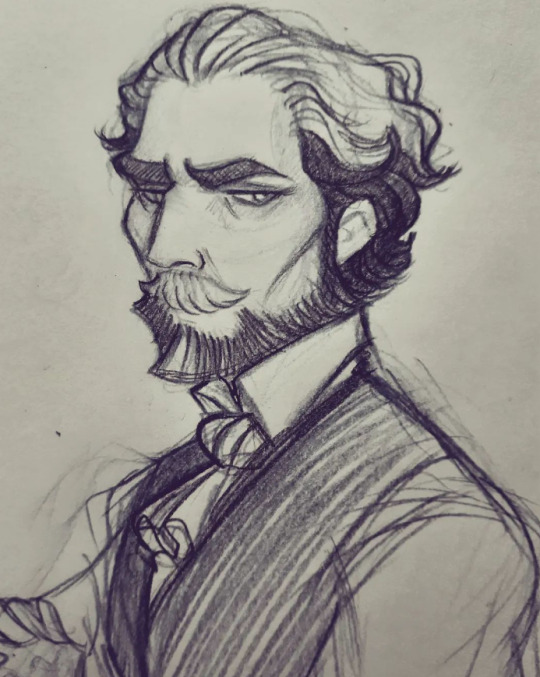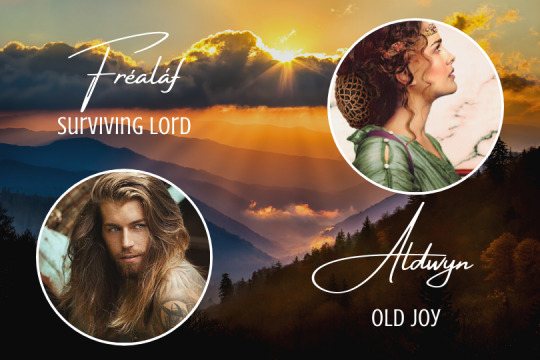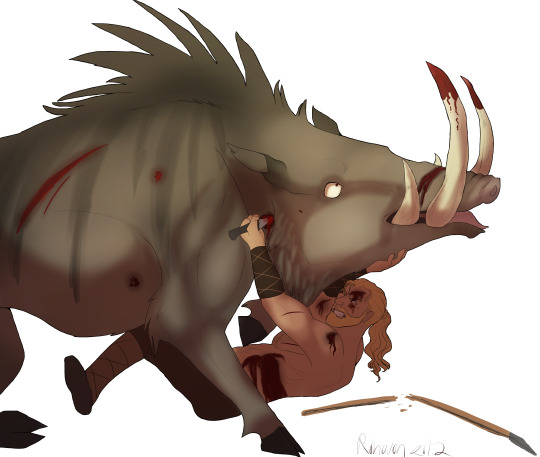#everholt
Text

A doodle of Mr. Crowle, an ex-mafia leader with questionable parenting tactics from Everholt, which is a story I write with my SO, @singingofwinter!
I've been too busy to sketch anything these past weeks due to some life drama and commission work, so have this before I try to resume my quest in returning to more Dragon Age related shenanigans!
I'll probably focus mainly on my Inquisitor & Co. over here, but if you wanna see more of my original stories, I'm slowly but surely posting it on my BlueSky account!
8 notes
·
View notes
Text
Lipsync test of my character Angelo Llorente, along with Jacob Hart that belongs to @thesnowdragon ! Both from our shared story «Everholt». ;U; Having a blast with Procreate Dreams, and hope to utilize it more! Shared the TikTok version for now because of subtitles. 👀
#animation#lipsync animation#oc#oc animation#everholt#angelo llorente#jacob hart#frederico llorente#2d animation#rough animation#my art#my animation
2 notes
·
View notes
Note
I see you very much as an expert on all things Rohirrim, so I bring to you this question, hoping I can pick your brain for info to use in my own fics (full disclosure). 😅
It seems to be a popular fanon that the Rohirrim/Riders of Rohan have tattoos, and that body art is a part of their culture. Do you have any thoughts or personal HCs about this that you're willing to share?
Thank you in advance! I appreciate you and your blog so much (if you didn't already know that).
Oh my goodness!!! I am so very honored to be thought of as a person who is knowledgeable about my beloved Rohirrim, and I hope very much that I can live up to that reputation. Thank you!!!
I’m not aware of any real textual evidence for body art among the Rohirrim, and the historical record in the medieval Anglo Saxon and Norse societies that Tolkien used as a reference for them seems to be disputed. But I absolutely understand and agree with the conventional wisdom that tattoos are a thing in Rohan. It just fits well with a warrior culture that has a wilder, dare-I-say more pagan aesthetic as compared to the smooth solemnity of Gondor or the formal elegance of the elves. And since they’re a culture that doesn’t document things in written words, pictorial representations such as tattoos and body art would be one way to fill that gap (along with their songs and oral traditions).
In my mind, tattoos in Rohan are common but basic—they’ve really only got the technology for the “stick and poke” method so the designs are kept simple because anything too elaborate is difficult to pull off well. They’re mostly in black line (using soot) but some have color using powder made from grinding up certain dried roots and plants.
Each village/community has its own distinctive tattoo motif that is worn by all of that community’s members. So you can tell just by looking at someone whether they’re from Upbourn (a fish because it’s a river town) or Dunharrow (mountain peaks since they’re in the White Mountains) or Everholt (a boar in honor of the wild boar that live in this part of the Firien Wood), etc. And soldiers also tend to share tattoo designs specific to their éored—getting your éored’s mark is a formal rite of passage for the younger members when they first get assigned to their company. These shared tattoo designs are important both for group cohesion and as a means of identifying fallen Rohirrim even if the deceased isn’t known to whoever finds the body.
Beyond these ritualized and practical functions, I do also like to think that there are some purely decorative tattoos among them as a means of personal expression and/or to help cover small scars that so many Rohirrim have from battle, riding accidents or other mishaps. Obviously horse-based designs would be very popular, as well as other flora and fauna of Rohan. But they’re a very sentimental people and so I think little emotional signifiers would also be very common (again, especially because they generally don’t have a means to pay tribute to beloved people/things in written form, this sort of symbol would serve the purpose of making some kind of record of those tributes).
In terms of specific people in my head canon: Éomer has a little simbelmynë blossom for each of the major figures in his life that he’s lost (forearm). Háma had a sun to remind him of his wife, who brought warmth and light to his life (shoulder). Théodred had stars in the shape of a particular constellation that is visible every year on his mother’s birthday (chest). Éowyn has a representation of her father’s sword (left wrist) and gets a quill (right wrist) to represent Faramir after they get married. (Faramir got a little running horse in her honor on his first trip to Rohan. He was glad he did it, but he never wants to sit through that again.)
Merry brought tattooing back to the Shire when he showed up with a tobacco pipe on his bicep (both for its association with Buckland and in tribute to Théoden, whose last words to Merry were about smoking together someday when peace was restored). Unsurprisingly, tattoos did not catch on with the other hobbits, but Merry remains very proud of it.
Anywayyyy…I hope that was in any way helpful! Thanks so much for asking!! I remain a huge fan and am so grateful to you for helping convince me to put some of my thoughts and stories out there vs keeping them all in the confines of my own Google drive!
#lord of the rings#lotr#tolkien#asks#answered asks#rohan#rohirrim#éomer#éowyn#háma#théodred#merry#faramir#lotr headcanon#tattoos
55 notes
·
View notes
Photo

Boar
From the book “A Bestiary of Tolkien: A coloring book”. illustrations by Mauro Mazzara and Andrea Piparo.
9 notes
·
View notes
Text
Not that I needed an illustration of my last post, but immediately after making it I happened to open my copy of An Atlas of Tolkien by David Day (a well-respected Tolkien scholar) to this page, and hooooooo boy.

This is part of a larger project spanning several pages in the book to categorize all the creatures that appear in Middle-earth, and the information, even when factually correct, is organized in such a haphazard and inconsistent sort of way... let’s break it down. I don’t know enough about dragons in- or out-of-universe to really get into that line, so leave it for now, but the Maiar Demons line is interesting. “Kraken” is not a word that appears anywhere in Tolkien’s writing, but one might assume in this case it refers to the Watcher in the Water. The similarities are enough to stake an argument on, but in my opinion it’s an unwise word to use in this context, given the massive cultural connotation attached to it. More concerning is the fact that Mr. Day saw no need to clarify the creature he was referring to, when other creatures are identified individually, such as the Boar of Everholt under Beasts.
Absolutely fascinating that he chose to identify the Nazgûls’ fellbeasts as Maiar: they’re afforded little description but what is given leads to no assumption that they’re anything other than perfectly ordinary animals like the Nazgûls’ horses. “And behold! it was a winged creature: if bird, then greater than all other birds, and it was naked, and neither quill nor feather did it bear, and its vast pinions were as webs of hide between horned fingers; and it stank. A creature of an older world maybe it was, whose kind, lingering in forgotten mountains cold beneath the Moon, outstayed their day, and in hideous eyrie bred this last untimely brood, apt to evil. And the Dark Lord took it, and nursed it with fell meats, until it grew beyond the measure of all other things that fly; and he gave it to his servant to be his steed.” The only thing that hints at it not being as ordinary as a badger or fox, if rarer, is the “apt to evil” comment, but then wolves are also prone to evil in Middle-earth, so where’s their place on the list of things that are secretly demons?
I’m not going to get into the spiders because it’s been hashed out on this blog before, but suffice to say that while it’s not unreasonable to assume they’re Maiar, that can’t be said for certain, as it is here.
Interesting that goblins are listed as a subset of Orc when “orc” is literally just the hobbitish word for goblin.
Interesting that “wolf-rider” is listed as a subset of Orc when that’s. A job. That’s a job. That’s like listing “forklift operator” separately under “humans.”
No particular disagreement with the Troll line.
“Dwimmerlaik” is a Rohirric word that is used once in LotR, an apparently derisive term that Éowyn uses to address the Witch-king. It’s derived from Middle English “dweomerlak,” which refers to dark magic, and seems in context to mean something to the effect of “evildoer specializing in magic.” So. Uh. That’s an insult. Different types of wraiths: Nazgûl, Barrow-wights, asswipes.
Indifferent to the Birds line.
“Oliphaunt” is just the hobbitish word for “Mûmak,” so I don’t know why they’re being listed as a subset of “Mûmak.” Similarly, I don’t know why horses are listed as a subset of “Mearas” when a Mearas is just a specific type of horse, much like a pony. Unless of course the implication is that ponies were bred from regular horses which were bred from Mearas, which is A) factually incorrect and B) implies a family tree sort of layout to this whole thing, implying that theoretically, if you go far enough back, a Mearas was more or less the same thing as a Mûmak, or a wolf. I wonder what those kids would have looked like.
Main issue with the Insect line is [insert “Graphic Design is My Passion” meme here].
None of this is particular shade on David Day, but assumptions were made, things are presented as factual with little to no evidence (an ongoing issue with him -- it’s been ages since I read The Tolkien Bestiary but mmmmmmm), and the information isn’t categorized in a logical or consistent manner. I love David Day’s work! It makes looking stuff up fast and easy, and it was an amazing introduction for little kid Snowy into the world of literary criticism. Plus many of his theories and analyses are absolutely fascinating. I highly recommend them. However. I don’t consider it somehow more legitimate than my own analyses beyond his simple advantage in years spent doing it, not when he appears to have simply not brushed up on the source material in many cases. Certainly his status as a Tolkien scholar does not render him immune to making mistakes.
#lotr#less an issue with any of this categorization but while flipping through it i noticed that a lot of it is#exactly the categorization used in lotro#eyes emoji#long post#anyway point is i love the fact that there are people out there digging into this and writing these books and essays and stuff#theyre not infallible and anyone who thinks they are can fuck right off#also re: fellbeasts: theyre pterodactyls aint they
24 notes
·
View notes
Photo




men of middle-earth ♞ house of éorl ♞ headcanon disclaimer
Ethelward was the son of Hild, the nephew to Helm Hammerhand, and the tenth King of Rohan, first of the second line. Alongside his mother, he led a surprise raid to retake Edoras from the usurper-king Wulf, and afterward claimed the kingship of Rohan with the support of his cousin Saulwyn, daughter and last remaining family member of Helm. As king, he took the name Fréaláf, “surviving lord,” and worked to free Rohan from its Dunlendish conquerors.
In this he at last had the aid of Gondor, who had been struggling against their own enemies during the Long Winter but were finally free to fulfill the Oath of Círion and Éorl. Fréaláf and his allies drove their enemies back across the rivers Isen and Adorn and laid siege to Isengard until the Dunlendings who had occupied were starved and capitulated, fleeing the fortress.
At Fréaláf’s coronation ceremony, the wizard Saruman suddenly appeared after a long period of absence, offering his support to Rohan, which Fréaláf accepted gladly. At the advice of Fréaláf, Steward Beren of Gondor lent Saruman the keys of Orthanc, giving him leave to dwell in Isengard if he would protect it from another conquest.
Fréaláf was succeeded by his son Brytta, who continued his legacy of sending aid to those in need. This generosity earned him the name Léofa, “beloved,” first coined by his mother Aldwyn, who survived her kingly husband, and later adopted by all the people of Rohan. In addition to rebuilding his kingdom, Brytta defended his borders against the Dunlendings and faced a new threat when orcs invaded the White Mountains after their defeat in the distant War of the Dwarves and Orcs. Brytta fought them off, and when he died it was believed that Rohan was at last free of all intruders.
The wife of Brytta Léofa was Mildgith, a shieldmaiden who fought alongside him to restore Rohan. Mildgith bore her husband a son, Walda, who served in his father’s army fighting off orcs in the White Mountains. When Walda inherited the throne of Rohan, he declared his lands free of enemies, but after only nine years of his reign he discovered this was not true when he was attacked by a last roving band of orcs in the mountains near Dunharrow. Walda and his men were killed, with only Queen Eafled his wife surviving to bear the grievous news back to Edoras.
Walda’s son Folca took the crown and swore to avenge his father. He was renowned as a great hunter, clearing all of Rohan from the scourge of the orcs. This campaign took thirteen years, and when it was over Folca soon grew eager to hunt again. He searched far and wide for a prey worthy of his attentions, discovering it in the form of the monstrous Boar of Everholt. Though his wife Darwise begged him to leave it be, Folca rode out chasing the thrill of another great hunt, but Darwise’s counsel proved true in the end: though he slew the boar in the end, the beast gored him with its tusks, leaving him with mortal wounds. Upon his death, Folca was succeeded by his son Folcwine.
#tolkienedit#oneringnet#lotr#rohan#rohirrim#frealaf#oc aldwyn#brytta#oc mildgith#walda#oc eafled#folca#oc darwise#my edit#my writing#edit writing#headcanons#tefain nin#men of middle earth#house of eorl
22 notes
·
View notes
Photo

folca vs the boar of everholt...the former perishing as well from the fight.
full version under the read more for gore and animal death

#folca#rohan#lotr#the lord of the rings#blood tw#animal death#i did NOT want to do a background so uh#*gently places this down*#and that concludes all the lotr stuff :)#onto unfinished tales#for context ive been rereading the legenderium and drawing scenes that formed a clear image in my mind#i actually..started halway in rotk so ill eventually get to the silm and hobbit lmafo
10 notes
·
View notes
Text
«Gee, you’re beautiful.» || Animation from Everholt
This short animation features Elizabetha Lightwood and Kjell Blackett Kane from “Everholt”, a story I am creating with my SO @thesnowdragon / @mieran-sanctuary ! I had a period earlier this year where I did lots of practice animation runs, just to try out lipsyncing again. Safe to say, I am SOOOO excited for Procreate Dreams!
PS! The timing is very off here because of exporting it from TikTok, but hope it can still be enjoyable.
#animation#rough animation#2d animation#sketch animation#oc#oc art#oc animation#ocs#oc couple#everholt#elizabetha#kjell
0 notes
Text

Odette Everly being her angry self!
#animation#2D animation#Odette everly#Everholt#old animation but thought I would share!#oc#oc art#oC animation#rough animation#my art#my animation
0 notes